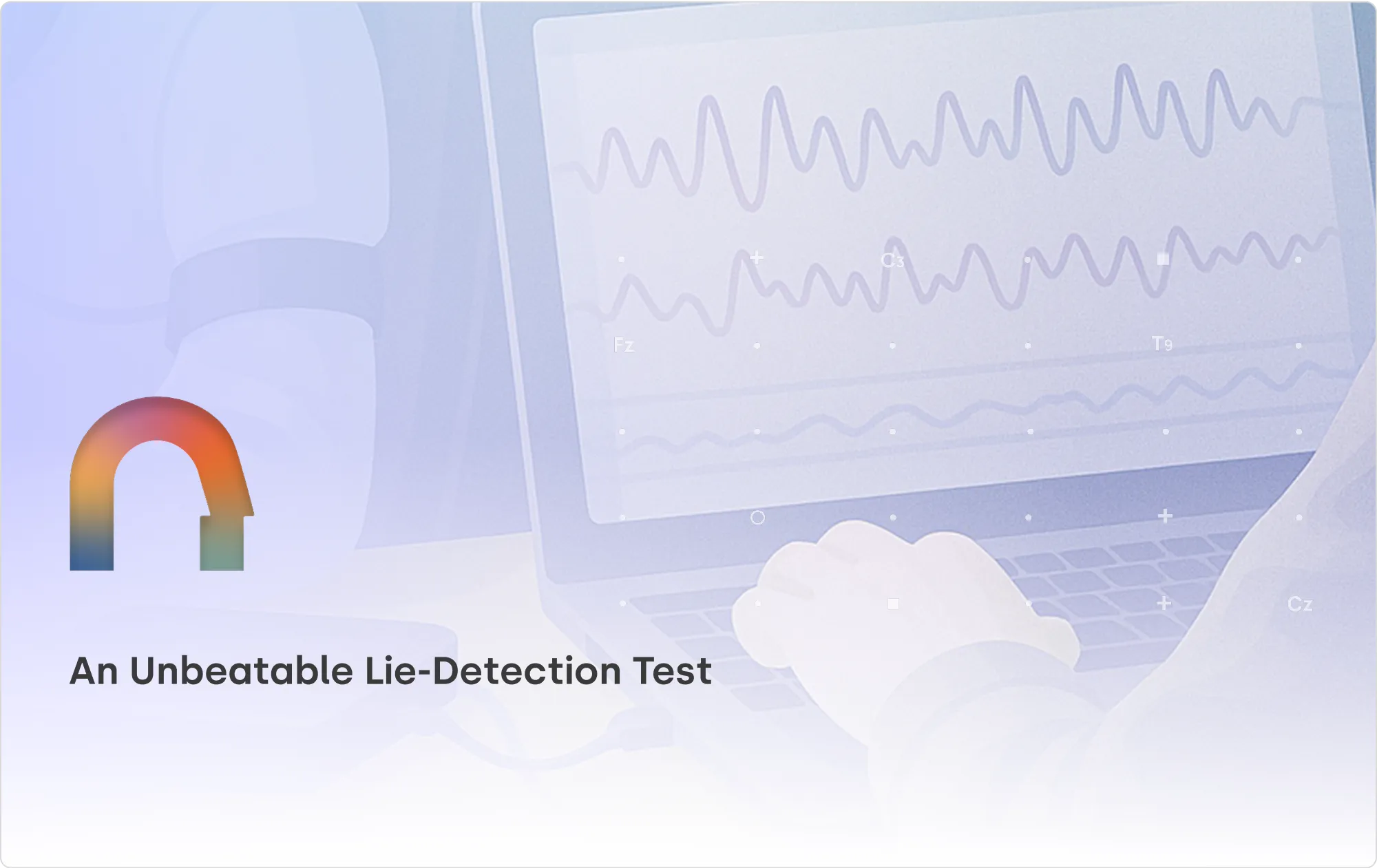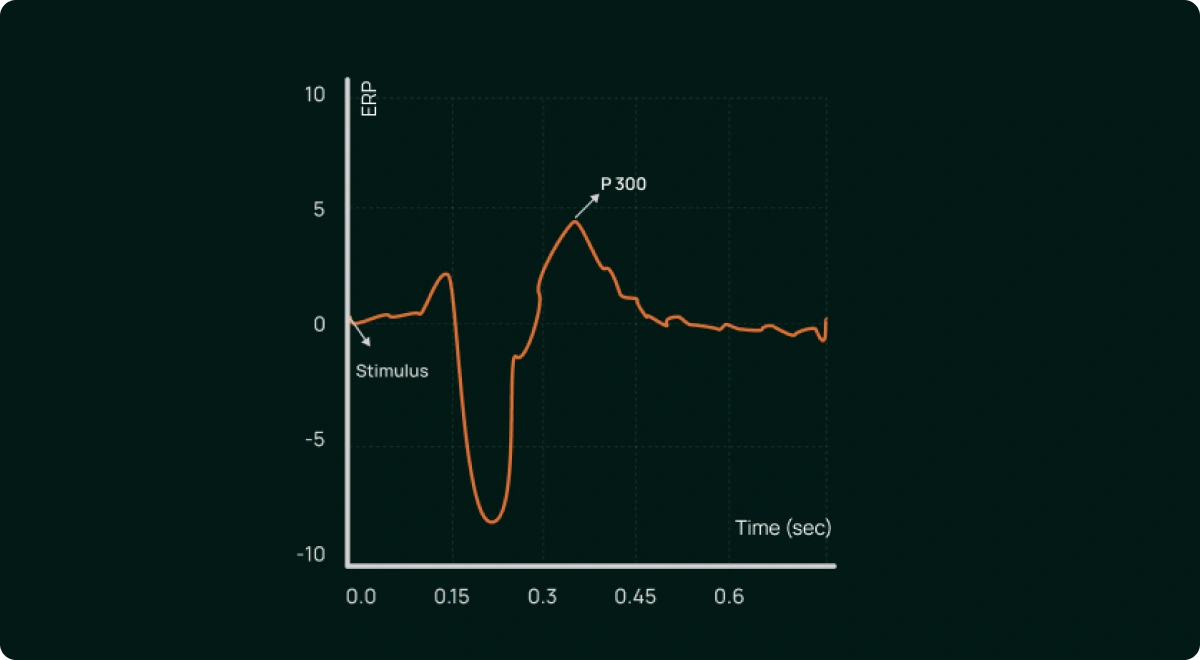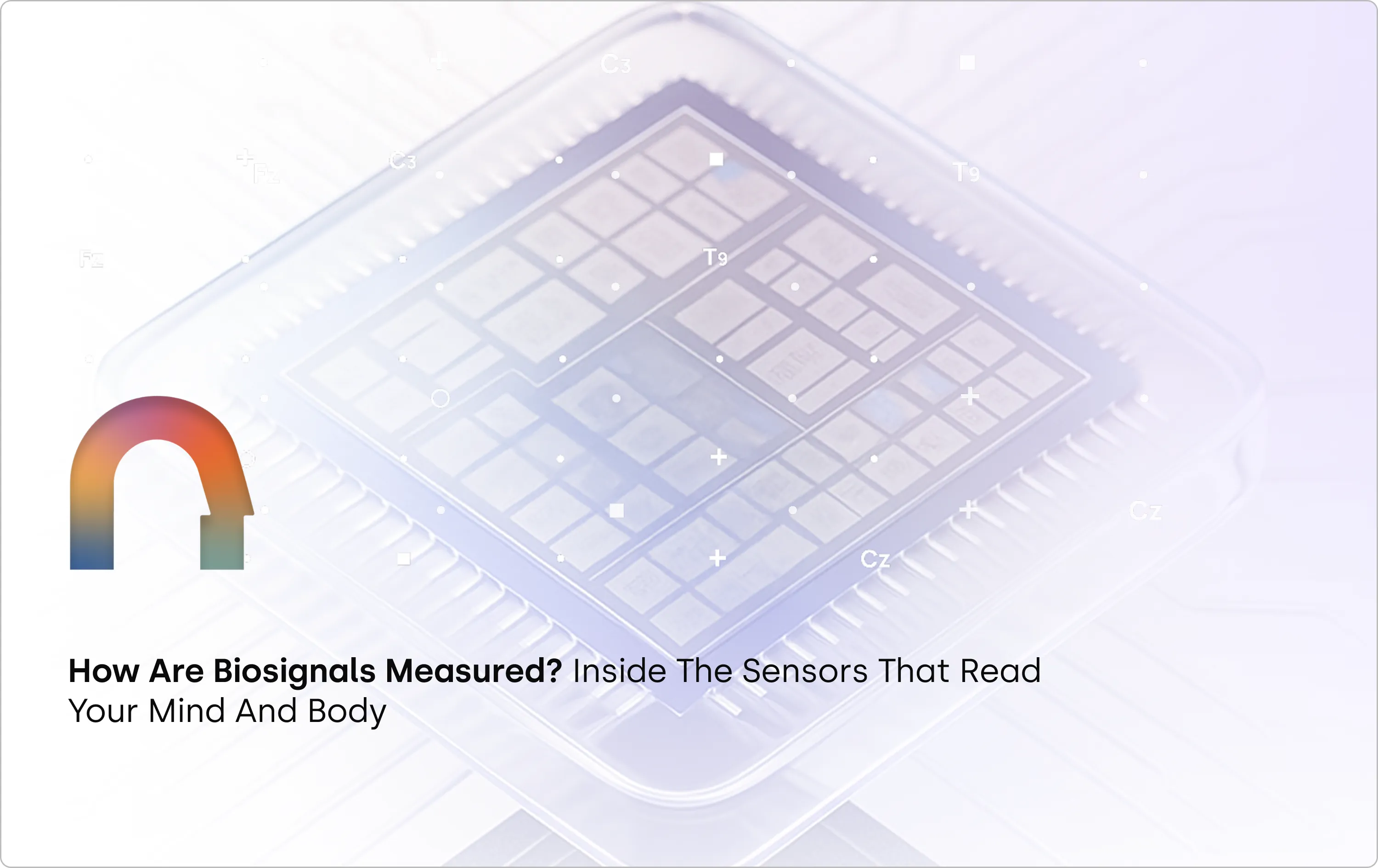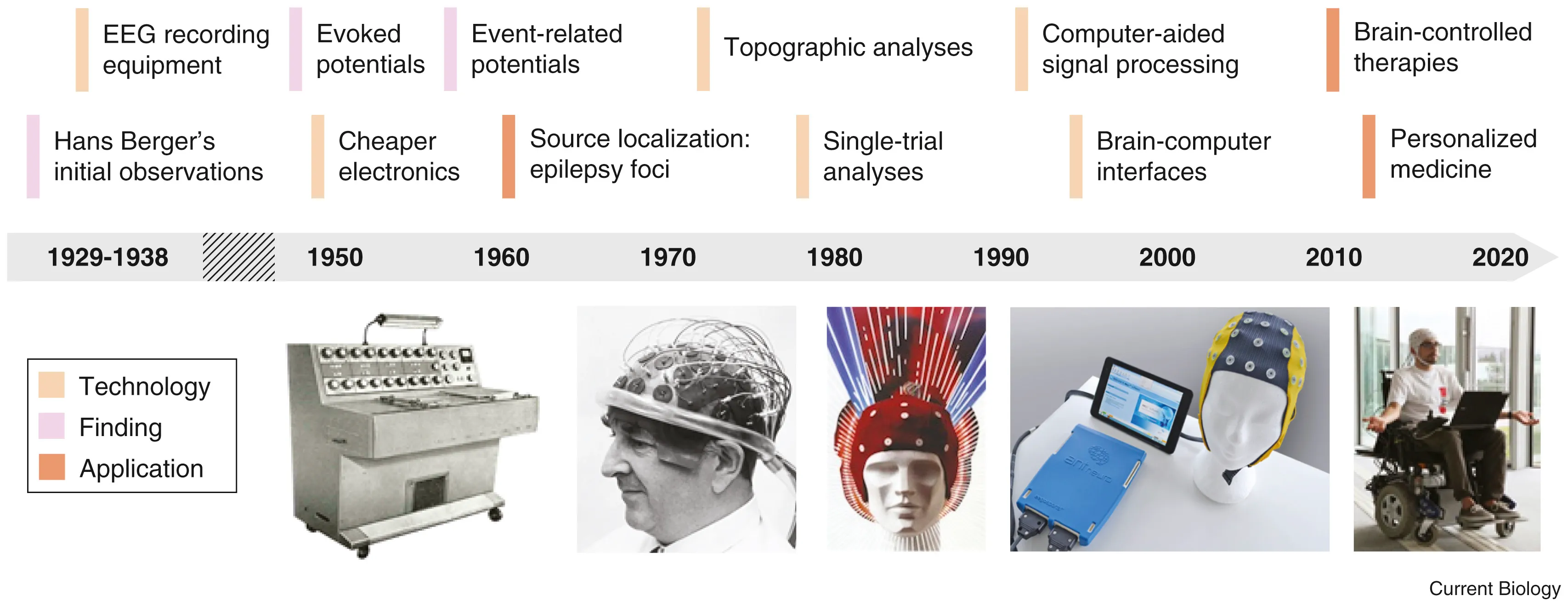An unbeatable lie-detection test
Did you know that it is possible to for a person to pass a lie detection test by exerting control over their physiological responses. Here we explore what would be an alternative to the common polygraph lie detection test using BCI technology.

Lie detection tests, often portrayed in movies as dramatic showdowns, are actually fascinating tools used in real-life scenarios. The most common method, the polygraph test, measures physiological responses like heart rate, blood pressure, and skin conductivity to assess truthfulness. While it's not foolproof and relies on the assumption that lying induces detectable physiological changes, it can be surprisingly accurate. The examiner sets the baseline by asking innocuous questions, then delves into the more critical queries. It's like a high-stakes game of poker, where involuntary reactions become the telltale signs. The results are akin to a puzzle for seasoned professionals, decoding the body's subtle cues to separate fact from fiction.
But there is a catch. It is possible for a person to potentially pass a lie detection test by exerting control over their physiological responses. This can be achieved through various techniques such as controlled breathing, mental distraction, or even the use of countermeasures like imagining stressful situations during baseline questions. Skilled individuals who are aware of these techniques may attempt to manipulate the results of the test. Additionally, some individuals may naturally exhibit limited physiological responses even when lying, making them more challenging to detect. So, despite its intriguing potential, lie detection tests aren't infallible and require skilled interpretation. They serve as one piece of the puzzle in investigations, reminding us that even in the quest for truth, human intuition and analysis remain paramount.
Electroencephalography (EEG)
It can be a more reliable alternative to polygraph tests. One may have semi-voluntary control over their physiological responses, but many internal mental responses are involuntary in nature. These responses can be reliably captured, and then recognized as patterns in EEG data. The P300 is one such pattern that can be used in lie-detection tests. All we need is a carefully designed environment, EEG recording setup, our prime suspect, and an invigilator - which could be another human or a simple computer program.
Picture P300 as your mental drum-roll, happening about 300 milliseconds after something catches your brain's eye. Now, here's the fun part: The brain throws this P300 party with a twist called the "oddball paradigm." It's like serving up a mix of familiar and surprise treats to your brain. When that surprise treat pops up, the P300 struts onto the scene, stealing the show with its snazzy moves! This P300 sensation isn't just for kicks though! It's your brain's secret agent, helping you focus on what really matters in a sea of distractions. It's like having a personal brain butler that whispers, "Hey, pay attention to this!"


Role of P300 EEG Patterns
Let’s Imagine a scenario in a police investigation room to see how we can use P300 EEG patterns. Detective Anderson is questioning a suspect, John, about a recent burglary. John maintains his innocence, but Detective Anderson has reasons to suspect otherwise. This is where the P300, our cognitive truth-seeker, comes into play.
Detective Anderson has a set of statements related to the crime. Among them, there's one crucial statement he believes holds the truth: the location of a hidden stash of stolen goods. This statement is intermixed with other neutral statements to form a series.
John is instructed to respond truthfully to all statements. However, when he hears the statement about the hidden stash, he experiences a slight cognitive hiccup. This is because his brain, even though he's trying to hide it, recognizes the statement as relevant and unexpected. The P300, our lie-detecting superhero, picks up on this subtle brainwave pattern.
Meanwhile, electrodes placed on John's scalp are recording his brain activity. The EEG machine diligently captures the electrical signals generated by John's brain in response to each statement. When the statement about the hidden stash is presented, the P300 response emerges about 300 milliseconds later.
Detective Anderson, relying on the expertise of trained analysts and specialized software, examines the EEG data. They focus on the P300 response specifically, looking for distinct patterns that indicate heightened cognitive processing associated with the relevant statement.
In this case, the P300 signal corresponding to the statement about the hidden stash exhibits a stronger and more pronounced waveform compared to the neutral statements. This heightened P300 response is a telltale sign that John's brain recognizes the statement as important, suggesting he likely has knowledge of the hidden goods.
This crucial information becomes a powerful tool for Detective Anderson. While it doesn't serve as definitive proof of guilt, it provides a significant lead. It prompts further investigation, potentially leading to the recovery of the stolen items and strengthening the case against John.
Remember, this is a fictional scenario for illustrative purposes. In reality, things are not as simplistic. We would still need careful experimental design, scientific data analysis, and expert interpretation.
Current State of Research
A. Advancements in Signal Processing and Machine Learning
Researchers have made strides in refining signal processing techniques and applying machine learning algorithms to improve the accuracy and reliability of P300-based lie detection.
B. Integration with Multimodal Techniques
Combining EEG with other neuro-imaging methods (e.g., fMRI, eye-tracking) has shown promise in enhancing the accuracy of lie detection by providing complementary information.
C. Applied in Specific Contexts
P300-based lie detection has been explored in various domains, including criminal investigations, security screenings, and clinical assessments. It's important to note that it's not yet widely accepted for legal or forensic use in many jurisdictions.
D. BCIs and Assistive Technology
Beyond lie detection, the P300 has found applications in Brain-Computer Interfaces (BCIs), enabling individuals with motor disabilities to communicate or interact with their environment.
E. Potential Clinical Applications
P300-based research is extending into clinical areas, such as assessing cognitive functions in patients with brain injuries or neuro-degenerative disorders.
Challenges:
1. Individual Variability
Brainwave patterns can vary widely among individuals. This variability poses a challenge in developing a universal lie detection model that applies to all.
2. Ethical and Legal Considerations
The admissibility of P300-based lie detection in legal settings remains a subject of debate. False positives and negatives can have significant consequences, so ethical and legal frameworks must be carefully considered.
3. Real-World Context and Stress
Laboratory experiments may not fully capture the complexity and stress of real-world situations, where emotions, distractions, and high-stakes scenarios can influence results.
4. Interpretation of Results
While the P300 provides valuable information, interpreting its presence or absence requires expert knowledge and careful consideration of experimental design.
5. Cost and Accessibility
EEG equipment and expertise in analysis can be expensive and require specialized training, limiting the accessibility of P300-based lie detection methods.
6. Continual Technological Advancements
The field of EEG and lie detection is rapidly evolving. Keeping up with the latest technology and methodologies is crucial for accurate and reliable results.
In summary, while P300-based lie detection holds promise, it's not without its challenges. Ongoing research and advancements in technology, coupled with careful consideration of ethical and legal implications, are essential in moving this field forward.
Further reading:
- For deep dive into the P300 pattern -
The P300 Wave of the Human Event-Related Potential - P300 based lie detection-
Evaluation of P300 based Lie Detection Algorithm
P300 Based Deception Detection Using Convolutional Neural Networks
An experiment of lie detection based EEG-P300 classified by SVM algorithm - Other ways of lie detection using EEG-
Truth Identification from EEG Signal by using Convolution neural network: Lie Detection
Truth Identification from EEG Signal Using Frequency and Time Features with SVM Classifier

Capturing a biosignal is only the beginning. The real challenge starts once those tiny electrical fluctuations from your brain, heart, or muscles are recorded. What do they mean? How do we clean, interpret, and translate them into something both the machine and eventually we can understand? In this blog, we move beyond sensors to the invisible layer of algorithms and analysis that turns raw biosignal data into insight. From filtering and feature extraction to machine learning and real-time interpretation, this is how your body’s electrical language becomes readable.
Every heartbeat, every blink, every neural spark produces a complex trace of electrical or mechanical activity. These traces known collectively as biosignals are the raw currency of human-body intelligence. But in their raw form they’re noisy, dynamic, and difficult to interpret.
The transformation from raw sensor output to interpreted understanding is what we call biosignal processing. It’s the foundation of modern neuro- and bio-technology, enabling everything from wearable health devices to brain-computer interfaces (BCIs).
The Journey: From Raw Signal to Insight
When a biosignal sensor records, it captures a continuous stream of data—voltage fluctuations (in EEG, ECG, EMG), optical intensity changes, or pressure variations.
But that stream is messy. It includes baseline drift, motion artefacts, impedance shifts as electrodes dry, physiological artefacts (eye blinks, swallowing, jaw tension), and environmental noise (mains hum, electromagnetic interference).
Processing converts this noise-ridden stream into usable information, brain rhythms, cardiac cycles, muscle commands, or stress patterns.
Stage 1: Pre-processing — Cleaning the Signal
Before we can make sense of the body’s signals, we must remove the noise.
- Filtering: Band-pass filters (typically 0.5–45 Hz for EEG) remove slow drift and high-frequency interference; notch filters suppress 50/60 Hz mains hum.
- Artifact removal: Independent Component Analysis (ICA) and regression remain the most common methods for removing eye-blink (EOG) and muscle (EMG) artefacts, though hybrid and deep learning–based techniques are becoming more popular for automated denoising.
- Segmentation / epoching: Continuous biosignals are divided into stable time segments—beat-based for ECG or fixed/event-locked windows for EEG (e.g., 250 ms–1 s)—to capture temporal and spectral features more reliably.
- Normalization & baseline correction: Normalization rescales signal amplitudes across channels or subjects, while baseline correction removes constant offsets or drift to align signals to a common reference.
Think of this stage as cleaning a lens: if you don’t remove the smudges, everything you see through it will be distorted.
Stage 2: Feature Extraction — Finding the Patterns
Once the signal is clean, we quantify its characteristics, features that encode physiological or cognitive states.
Physiological Grounding
- EEG: Arises from synchronized postsynaptic currents in cortical pyramidal neurons.
- EMG: Records summed action potentials from contracting muscle fibers.
- ECG: Reflects rhythmic depolarization of cardiac pacemaker (SA node) cells.
Time-domain Features
Mean, variance, RMS, and zero-crossing rate quantify signal amplitude and variability over time. In EMG, Mean Absolute Value (MAV) and Waveform Length (WL) reflect overall muscle activation and fatigue progression.
Frequency & Spectral Features
The power of each EEG band tends to vary systematically across mental states.

Time–Frequency & Non-Linear Features
Wavelet transforms or Empirical Mode Decomposition capture transient events. Entropy- and fractal-based measures reveal complexity, useful for fatigue or cognitive-load studies.
Spatial Features
For multi-channel EEG, spatial filters such as Common Spatial Patterns (CSP) isolate task-specific cortical sources.
Stage 3: Classification & Machine Learning — Teaching Machines to Read the Body
After feature extraction, machine-learning models map those features to outcomes: focused vs fatigued, gesture A vs gesture B, normal vs arrhythmic.
- Classical ML: SVM, LDA, Random Forest , effective for curated features.
- Deep Learning: CNNs, LSTMs, Graph CNNs , learn directly from raw or minimally processed data.
- Transfer Learning: Improves cross-subject performance by adapting pretrained networks.
- Edge Inference: Deploying compact models (TinyML, quantized CNNs) on embedded hardware to achieve < 10 ms latency.
This is where raw physiology becomes actionable intelligence.
Interpreting Results — Making Sense of the Numbers
A robust pipeline delivers meaning, not just data:
- Detecting stress or fatigue for adaptive feedback.
- Translating EEG patterns into commands for prosthetics or interfaces.
- Monitoring ECG spectral shifts to flag early arrhythmias.
- Quantifying EMG coordination for rehabilitation or athletic optimization.
Performance hinges on accuracy, latency, robustness, and interpretability, especially when outcomes influence safety-critical systems.
Challenges and Future Directions
Technical: Inter-subject variability, electrode drift, real-world noise, and limited labeled datasets still constrain accuracy.
Ethical / Explainability: As algorithms mediate more decisions, transparency and consent are non-negotiable.
Multimodal Fusion: Combining EEG + EMG + ECG data improves reliability but raises synchronization and power-processing challenges.
Edge AI & Context Awareness: The next frontier is continuous, low-latency interpretation that adapts to user state and environment in real time.
Final Thought
Capturing a biosignal is only half the story. What truly powers next-gen neurotech and human-aware systems is turning that signal into sense. From electrodes and photodiodes to filters and neural nets, each link in this chain brings us closer to devices that don’t just measure humans; they understand them.

Every thought, heartbeat, and muscle twitch leaves behind a signal, but how do we actually capture them? In this blog post, we explore the sensors that make biosignal measurement possible, from EEG and ECG electrodes to optical and biochemical interfaces, and what it takes to turn those signals into meaningful data.
When we think of sensors, we often imagine cameras, microphones, or temperature gauges. But some of the most fascinating sensors aren’t designed to measure the world, they’re designed to measure you.
These are biosignal sensors: tiny, precise, and increasingly powerful tools that decode the electrical whispers of your brain, heart, and muscles. They're the hidden layer enabling brain-computer interfaces, wearables, neurofeedback systems, and next-gen health diagnostics.
But how do they actually work? And what makes one sensor better than another?
Let’s break it down, from scalp to circuit board.
First, a Quick Recap: What Are Biosignals?
Biosignals are the body’s internal signals, electrical, optical, or chemical , that reflect brain activity, heart function, muscle movement, and more. If you’ve read our earlier post on biosignal types, you’ll know they’re the raw material for everything from brain-computer interfaces to biometric wearables.
In this blog, we shift focus to the devices and sensors that make it possible to detect these signals in the real world, and what it takes to do it well.
The Devices That Listen In: Biosignal Sensor Types
.webp)
A Closer Look: How These Sensors Work
1. EEG / ECG / EMG – Electrical Sensors
These measure voltage fluctuations at the skin surface, caused by underlying bioelectric activity.
It’s like trying to hear a whisper in a thunderstorm; brain and muscle signals are tiny, and will get buried under noise unless the electrodes make solid contact and the amplifier filters aggressively.
There are two key electrode types:
- Wet electrodes: Use conductive gel or Saline for better signal quality. Still the gold standard in labs.
- Dry electrodes: More practical for wearables but prone to motion artifacts and noise (due to higher electrode resistance).
Signal acquisition often involves differential recording and requires high common-mode rejection ratios (CMRR) to suppress environmental noise.
Fun Fact: Even blinking your eyes generates an EMG signal that can overwhelm EEG data. That’s why artifact rejection algorithms are critical in EEG-based systems.
2. Optical Sensors (PPG, fNIRS)
These use light to infer blood flow or oxygenation levels:
- PPG: Emits light into the skin and measures reflection, pulsatile blood flow alters absorption.
- fNIRS: Uses near-infrared light to differentiate oxygenated vs. deoxygenated hemoglobin in the cortex.
Example: Emerging wearable fNIRS systems like Kernel Flow and OpenBCI Galea are making brain oxygenation measurement accessible outside labs.
3. Galvanic Skin Response / EDA – Emotion’s Electrical Signature
GSR (also called electrodermal activity) sensors detect subtle changes in skin conductance caused by sweat gland activity, a direct output of sympathetic nervous system arousal. When you're stressed or emotionally engaged, your skin becomes more conductive, and GSR sensors pick that up.
These sensors apply a small voltage across two points on the skin and track resistance over time. They're widely used in emotion tracking, stress monitoring, and psychological research due to their simplicity and responsiveness.
Together, these sensors form the foundation of modern biosignal acquisition — but capturing clean signals isn’t just about what you use, it’s about how you use it.
How Signal Quality Is Preserved
Measurement is just step one; capturing clean, interpretable signals involves:
- Analog Front End (AFE): Amplifies low signals while rejecting noise.
- ADC: Converts continuous analog signals into digital data.
- Signal Conditioning: Filters out drift, DC offset, 50/60Hz noise.
- Artifact Removal: Eye blinks, jaw clenches, muscle twitches.
Hardware platforms like TI’s ADS1299 and Analog Devices’ MAX30003 are commonly used in EEG and ECG acquisition systems.
New Frontiers in Biosignal Measurement
- Textile Sensors: Smart clothing with embedded electrodes for long-term monitoring.
- Biochemical Sensors: Detect metabolites like lactate, glucose, or cortisol in sweat or saliva.
- Multimodal Systems: Combining EEG + EMG + IMU + PPG in unified setups to boost accuracy.
A recent study involving transradial amputees demonstrated that combining EEG and EMG signals via a transfer learning model increased classification accuracy by 2.5–4.3% compared to EEG-only models.
Other multimodal fusion approaches, such as combining EMG and force myography (FMG), have shown classification improvements of over 10% compared to EMG alone.
Why Should You Care?
Because how we measure determines what we understand, and what we can build.
Whether it's a mental wellness wearable, a prosthetic limb that responds to thought, or a personalized neurofeedback app, it all begins with signal integrity. Bad data means bad decisions. Good signals? They unlock new frontiers.
Final Thought
We’re entering an era where technology doesn’t just respond to clicks, it responds to cognition, physiology, and intent.
Biosignal sensors are the bridge. Understanding them isn’t just for engineers; it’s essential for anyone shaping the future of human-aware tech.

In our previous blog, we explored how biosignals serve as the body's internal language—electrical, mechanical, and chemical messages that allow us to understand and interface with our physiology. Among these, electrical biosignals are particularly important for understanding how our nervous system, muscles, and heart function in real time. In this article, we’ll take a closer look at three of the most widely used electrical biosignals—EEG, ECG, and EMG—and their growing role in neurotechnology, diagnostics, performance tracking, and human-computer interaction. If you're new to the concept of biosignals, you might want to check out our introductory blog for a foundational overview.
"The body is a machine, and we must understand its currents if we are to understand its functions."-Émil du Bois-Reymond, pioneer in electrophysiology.
Life, though rare in the universe, leaves behind unmistakable footprints—biosignals. These signals not only confirm the presence of life but also narrate what a living being is doing, feeling, or thinking. As technology advances, we are learning to listen to these whispers of biology. Whether it’s improving health, enhancing performance, or building Brain-Computer Interfaces (BCIs), understanding biosignals is key.
Among the most studied biosignals are:
- Electroencephalogram (EEG) – from the brain
- Electrocardiogram (ECG) – from the heart
- Electromyogram (EMG) – from muscles
- Galvanic Skin Response (GSR) – from skin conductance
These signals are foundational for biosignal processing, real-time monitoring, and interfacing the human body with machines. In this article we look at some of these biosignals and some fascinating stories behind them.
Electroencephalography (EEG): Listening to Brainwaves
In 1893, a 19 year old Hans Berger fell from a horse and had a near death experience. Little did he know that it would be a pivotal moment in the history of neurotechnology. The same day he received a telegram from his sister who was extremely concerned for him because she had a bad feeling. Hans Berger was convinced that this was due to the phenomenon of telepathy. After all, it was the age of radio waves, so why can’t there be “brain waves”? In his ensuing 30 year career telepathy was not established but in his pursuit, Berger became the first person to record brain waves.
When neurons fire together, they generate tiny electrical currents. These can be recorded using electrodes placed on the scalp (EEG), inside the skull (intracranial EEG), or directly on the brain (ElectroCorticogram). EEG signal processing is used not only to understand the brain’s rhythms but also in EEG-based BCI systems, allowing communication and control for people with paralysis. Event-Related Potentials (ERPs) and Local Field Potentials (LFPs) are specialized types of EEG signals that provide insights into how the brain responds to specific stimuli.

Electrocardiogram (ECG): The Rhythm of the Heart
The heart has its own internal clock which produces tiny electrical signals every time it beats. Each heartbeat starts with a small electrical impulse made by a special part of the heart called the sinoatrial (SA) node. This impulse spreads through the heart muscle and makes it contract, first the upper (atria) and then lower chambers (ventricles) – that’s what pumps blood. This process produces voltage changes, which can be recorded via electrodes on the skin.
This gives rise to the classic PQRST waveform, with each component representing a specific part of the heart’s cycle. Modern wearables and medical devices use ECG signal analysis to monitor heart health in real time.
Fun fact: The waveform starts with “P” because Willem Einthoven left room for earlier letters—just in case future scientists discovered pre-P waves! So, thanks to a cautious scientist, we have the quirky naming system we still follow today.

Electromyography (EMG): The Language of Movement
When we perform any kind of movement - lifting our arm, kicking our leg, smiling, blinking or even breathing- our brain sends electrical signals to our muscles telling them to contract. When these neurons, known as motor neurons fire they release electrical impulses that travel to the muscle, causing it to contract. This electrical impulse—called a motor unit action potential (MUAP)—is what we see as an EMG signal. So, every time we move, we are generating an EMG signal!

Medical Applications
Medically, EMG is used for monitoring muscle fatigue especially in rehabilitation settings and muscle recovery post-injury or surgery. This helps clinicians measure progress and optimize therapy. EMG can distinguish between voluntary and involuntary movements, making it useful in diagnosing neuromuscular disorders, assessing stroke recovery, spinal cord injuries, and motor control dysfunctions.
Performance and Sports Science
In sports science, EMG can tell us muscle-activation timing and quantify force output of muscle groups. These are important factors to measure performance improvement in any sport. The number of motor units recruited and the synergy between muscle groups, helps us capture “mind-muscle connection” and muscle memory. Such things which were previously spoken off in a figurative manner can be scientifically measured and quantified using EMG. By tracking these parameters we get a window into movement efficiency and athletic performance. EMG is also used for biofeedback training, enabling individuals to consciously correct poor movement habits or retrain specific muscles
Beyond medicine and sports, EMG is used for gesture recognition in AR/VR and gaming, silent speech detection via facial EMG, and next-gen prosthetics and wearable exosuits that respond to the user’s muscle signals. EMG can be used in brain-computer interfaces (BCIs), helping paralyzed individuals control digital devices or communicate through subtle muscle activity. EMG bridges the gap between physiology, behavior, and technology—making it a critical tool in healthcare, performance optimization, and human-machine interaction.
As biosignal processing becomes more refined and neurotech devices more accessible, we are moving toward a world where our body speaks—and machines understand. Whether it’s detecting the subtlest brainwaves, tracking a racing heart, or interpreting muscle commands, biosignals are becoming the foundation of the next digital revolution. One where technology doesn’t just respond, but understands.

